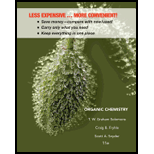
Interpretation:
The structures for the major products from the given reactions are to be written with stereoisomers where applicable.
Concept introduction:
Electrophiles are electron-deficient species, which has positive or partially positive charge. Lewis acids are electrophiles, which accept electron pair.
Nucleophiles are electron-rich species, which has negative or partially negative charge. Lewis bases are nucleophiles, which donate electron pair.
Substitution reaction: A reaction in which one of the hydrogens of a hydrocarbon or a functional group is substituted by any other functional group is called substitution reaction.
Elimination reaction: A reaction in which two substituent groups are detached and a double bond is formed is called elimination reaction.
Addition reaction: It is the reaction in which unsaturated bonds are converted to saturated molecules by addition of molecules.
Ozonolysis: An organic reaction in which the double bonds of
Markovnikov’s rule: The nucleophile attacks the carbon having less number of hydrogens.
When the order of progression from the group of highest priority to that of the next highest priority is clockwise, it is said to be the
When the order of progression from the group of highest priority to that of the next highest priority is anticlockwise, then it is said to be the
The mixture that contains equimolar quantity of two enantiomers is called a racemic mixture.
Want to see the full answer?
Check out a sample textbook solution
Chapter 8 Solutions
Organic Chemistry
- Suggest a possible reason for the following observations: (i) The order of reactivity of haloalkanes is RI > RCl > RBr. (ii) Neopentyl chloride (CH3)3CCH2Cl does not follow SN2 mechanism. (iii) Ethers have low boiling points.arrow_forward(1) (11) (111) (b)Give products and mechanisms for the following reactions. OH CH₂SO над сам _N_N_ но HO Barrow_forwardSN1 substitution and E1 elimination frequently compete in the same reaction.(a) Propose a mechanism and predict the products for the solvolysis of2-bromo-2,3,3-trimethylbutane in methanolarrow_forward
- Predict the major products of the following reactions, including stereochemistry where appropriate. (a) cyclopentylmethanol + Na2Cr2O7/H2SO4 (b) cyclopentanol + HCl/ZnCl2arrow_forwardThe following compound, 2-hydroxycycloheptatrienone, does not give all the usual carbonyl group reactions. (i) Explain this apparent anomaly. Furthermore, explain the significant difference between the relative stability of this compound and its 3- and 4-hydroxy isomers. (ii) What would you expect to be the influence of adding (a) a nitro group as a substituent on the 7-membered ring or (b) an alkyl group, on the degree of aromaticity of the above compound. (iii) Based on your understanding of the hydrogen bonding concept, which isomer would you expect to have a higher m.p, (assuming they are both solids) between 2- and 4- hydroxycycloheptatrienone? Explain your choice.arrow_forwardPredict the major products of the following reactions, including stereochemistry where appropriate. (a) n-butanol + HBr (b) cyclooctylmethanol + CH3CH2MgBrarrow_forward
- (a) Suggest a synthesis for the following molecules starting with benzene and any other necessary reagents. (i) H2N CI (ii) OH CN 6.arrow_forwardIdentify the major product(s) of the following reactions. Include stereochemistry. (a) (b) (c) Br NaOEt NaOEt NaOEtarrow_forward(c) The E2 elimination of bromoalkane 8 produces a range of alkenes as shown below, answer ALL parts (i) to (iii) Br 8 Ph NaOMe Ph 9 + FOUR more alkenes (i) Identify the structure of the four other possible alkene products. (ii) Assign the stereochemistry (E/Z) for all FIVE alkenes and explain which is likely to be the major product. (iii) With an explanation identify which stereoisomer of 8 would give alkene 9?arrow_forward
- (a) (b) (c) (d) Where products are missing, provide the structure of the major elimination product expected. Where the product is shown, draw the structure of the missing starting substrate necessary to complete each transformation. In all cases, show stereochemistry of the product clearly. CI ONa CI tok -OK Br OTS DBU DBU major alkene minor alkene major alkene minor alkene major alkene minor alkene major alkene minor alkenearrow_forward(a) Propose a mechanism for the conversion of cis-hex-3-ene to the epoxide (3,4-epoxyhexane)and the ring-opening reaction to give the glycol, hexane-3,4-diol. In your mechanism, payparticular attention to the stereochemistry of the intermediates and products.(b) Repeat part (a) for trans-hex-3-ene. Compare the products obtained from cis- andtrans-hex-3-ene. Is this reaction sequence stereospecific?arrow_forward2. (a) Give the product of the following reaction: Br t-BUOK (b) Using the FMOS of the reacting partners explain why this reaction is expected to occur simply on heating, in the absence of light. (c) Specify the preferred stereoisomer and explain why it is preferred.arrow_forward
 ChemistryChemistryISBN:9781305957404Author:Steven S. Zumdahl, Susan A. Zumdahl, Donald J. DeCostePublisher:Cengage Learning
ChemistryChemistryISBN:9781305957404Author:Steven S. Zumdahl, Susan A. Zumdahl, Donald J. DeCostePublisher:Cengage Learning ChemistryChemistryISBN:9781259911156Author:Raymond Chang Dr., Jason Overby ProfessorPublisher:McGraw-Hill Education
ChemistryChemistryISBN:9781259911156Author:Raymond Chang Dr., Jason Overby ProfessorPublisher:McGraw-Hill Education Principles of Instrumental AnalysisChemistryISBN:9781305577213Author:Douglas A. Skoog, F. James Holler, Stanley R. CrouchPublisher:Cengage Learning
Principles of Instrumental AnalysisChemistryISBN:9781305577213Author:Douglas A. Skoog, F. James Holler, Stanley R. CrouchPublisher:Cengage Learning Organic ChemistryChemistryISBN:9780078021558Author:Janice Gorzynski Smith Dr.Publisher:McGraw-Hill Education
Organic ChemistryChemistryISBN:9780078021558Author:Janice Gorzynski Smith Dr.Publisher:McGraw-Hill Education Chemistry: Principles and ReactionsChemistryISBN:9781305079373Author:William L. Masterton, Cecile N. HurleyPublisher:Cengage Learning
Chemistry: Principles and ReactionsChemistryISBN:9781305079373Author:William L. Masterton, Cecile N. HurleyPublisher:Cengage Learning Elementary Principles of Chemical Processes, Bind...ChemistryISBN:9781118431221Author:Richard M. Felder, Ronald W. Rousseau, Lisa G. BullardPublisher:WILEY
Elementary Principles of Chemical Processes, Bind...ChemistryISBN:9781118431221Author:Richard M. Felder, Ronald W. Rousseau, Lisa G. BullardPublisher:WILEY





